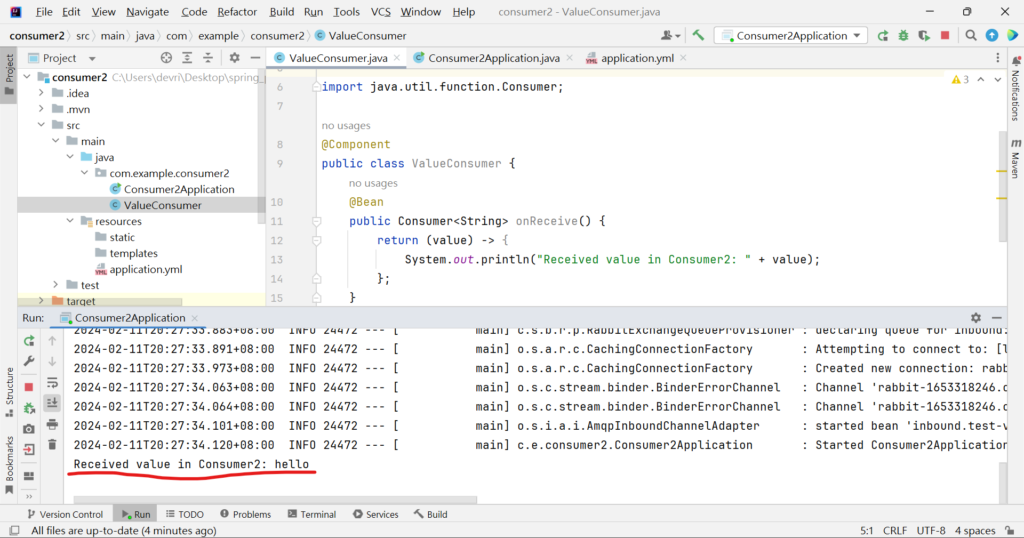Spring Cloud Stream 預設是使用 RabbitMQ 的 Exchange: topic 模式,但是如果我們想把資料傳送 (廣播) 到每個訂閱該 Exchange 的 Consumer 上,也就是俗稱的 Publish/Subscribe 模式,那我們需要使用 RabbitMQ 的 Exchange: fanout 模式才能做到,本文將介紹如何實作一個簡單的 fanout 模式範例程式。

開始實作:
首先使用 Docker 在本地端運行一個 RabbitMQ 服務,在終端機輸入以下指令:
$ docker run -e RABBITMQ_DEFAULT_USER=admin -e RABBITMQ_DEFAULT_PASS=123456 -p 5672:5672 -p 15672:15672 --rm rabbitmq:3.8-management運行成功後,可以使用 http://localhost:15672/ 開啟 RabbitMQ 的 Web 管理介面,帳號為 admin,密碼為 123456。
接著用 https://start.spring.io/ 建立一個新的 Spring Boot 專案,Artifact 為 producer;Dependencies 選擇 Spring Web、Cloud Stream、Spring for RabbitMQ。
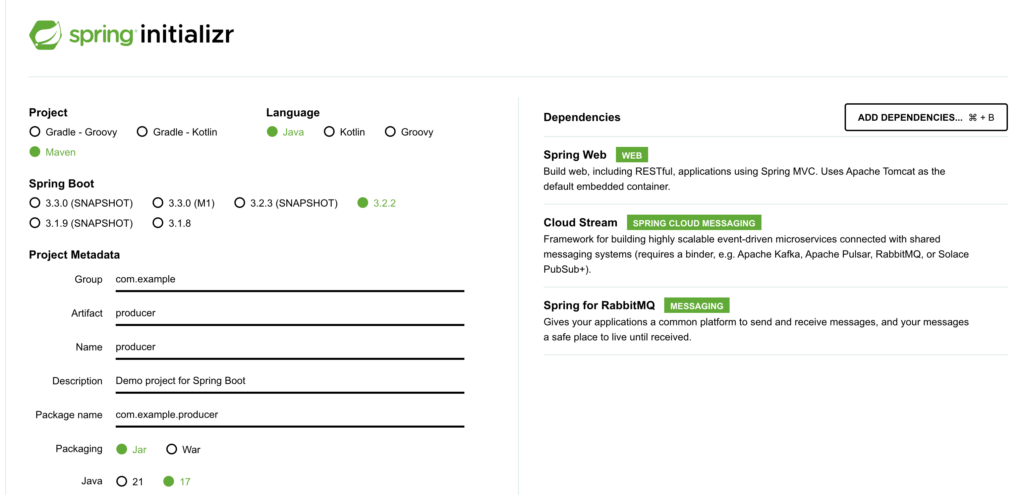
然後用 IntelliJ IDEA 開啟 producer 專案的 pom.xml 檔案,載入專案,然後新增一個 Java Class,名稱為 ValueController,並加入以下程式碼:
package com.example.producer;
import org.springframework.beans.factory.annotation.Autowired;
import org.springframework.cloud.stream.function.StreamBridge;
import org.springframework.http.ResponseEntity;
import org.springframework.web.bind.annotation.GetMapping;
import org.springframework.web.bind.annotation.PathVariable;
import org.springframework.web.bind.annotation.RestController;
@RestController
public class ValueController {
@Autowired
private StreamBridge streamBridge;
@GetMapping("values/{value}")
public ResponseEntity<String> values(@PathVariable String value) {
System.out.println("Sending value to topic: " + value);
streamBridge.send("test-values-topic", value);
return ResponseEntity.ok("ok");
}
}然後刪除 src/main/resources 下的 application.properties 檔案,在 src/main/resources 下新增一個 application.yml 檔案,並填入以下內容:
server:
port: 8080
spring:
cloud:
stream:
output-bindings: test-values-topic
rabbit:
bindings:
test-values-topic:
producer:
exchangeType: fanout
rabbitmq:
host: localhost
port: 5672
username: admin
password: 123456說明:spring.cloud.stream.output-bindings 指定 streamBridge.send() 輸出綁定的名稱,spring.cloud.stream.rabbit.bindings.test-values-topic.producer.exchangeType 設定為 fanout,這樣可以創造一個名為 test-values-topic 的 exchange,且 type 為 fanout。
接著運行 producer 這個 Spring Boot 程式,可以從 RabbitMQ Web 管理介面裡看到多了一個 test-values-topic 的 exchange,且 type 為 fanout,如下圖所示:
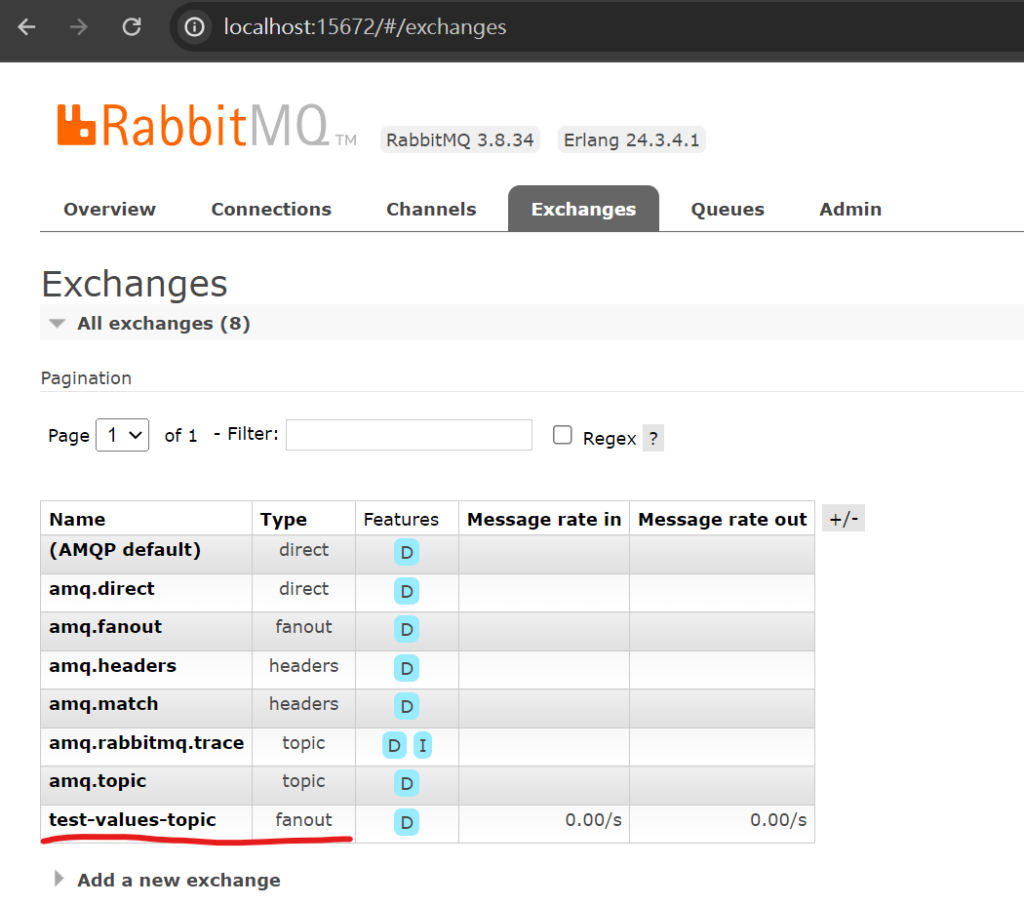
接著用 https://start.spring.io/ 建立一個新的 Spring Boot 專案,Artifact 為 consumer1;Dependencies 選擇 Spring Web、Cloud Stream、Spring for RabbitMQ。
然後用 IntelliJ IDEA 開啟 consumer1 專案的 pom.xml 檔案,載入專案,然後新增一個 Java Class,名稱為 ValueConsumer,並加入以下程式碼:
package com.example.consumer1;
import org.springframework.context.annotation.Bean;
import org.springframework.stereotype.Component;
import java.util.function.Consumer;
@Component
public class ValueConsumer {
@Bean
public Consumer<String> onReceive() {
return (value) -> {
System.out.println("Received value in Consumer1: " + value);
};
}
}然後刪除 src/main/resources 下的 application.properties 檔案,在 src/main/resources 下新增一個 application.yml 檔案,並填入以下內容:
server:
port: 8081
spring:
cloud:
function:
definition: onReceive
stream:
bindings:
onReceive-in-0:
destination: test-values-topic
group: myConsumer1
rabbit:
bindings:
onReceive-in-0:
consumer:
exchangeType: fanout
rabbitmq:
host: localhost
port: 5672
username: admin
password: 123456說明: spring.cloud.stream.bindings.onReceive-in-0.group 指定 queue 的後綴名稱,queue 的名稱會是 test-values-topic.myConsumer1。spring.cloud.stream.rabbit.bindings.onReceive-in-0.consumer.exchangeType 指定使用的 exchange type 為 fanout。
接著用 https://start.spring.io/ 建立一個新的 Spring Boot 專案,Artifact 為 consumer2;Dependencies 選擇 Spring Web、Cloud Stream、Spring for RabbitMQ。
然後用 IntelliJ IDEA 開啟 consumer2 專案的 pom.xml 檔案,載入專案,然後新增一個 Java Class,名稱為 ValueConsumer,並加入以下程式碼:
package com.example.consumer2;
import org.springframework.context.annotation.Bean;
import org.springframework.stereotype.Component;
import java.util.function.Consumer;
@Component
public class ValueConsumer {
@Bean
public Consumer<String> onReceive() {
return (value) -> {
System.out.println("Received value in Consumer2: " + value);
};
}
}然後刪除 src/main/resources 下的 application.properties 檔案,在 src/main/resources 下新增一個 application.yml 檔案,並填入以下內容:
server:
port: 8082
spring:
cloud:
function:
definition: onReceive
stream:
bindings:
onReceive-in-0:
destination: test-values-topic
group: myConsumer2
rabbit:
bindings:
onReceive-in-0:
consumer:
exchangeType: fanout
rabbitmq:
host: localhost
port: 5672
username: admin
password: 123456說明:注意這裡的 spring.cloud.stream.bindings.onReceive-in-0.group 是 myConsumer2, consumer1 跟 consumer2 必須使用不同的 queue,才能同時都收到訊息。
接著依序運行 consumer1、consumer2 這兩個 Spring Boot 程式,然後可以從 RabbitMQ Web 管理介面看到有 test-values-topic.myConsumer1 跟 test-values-topic.myConsumer2 這兩個 queue:
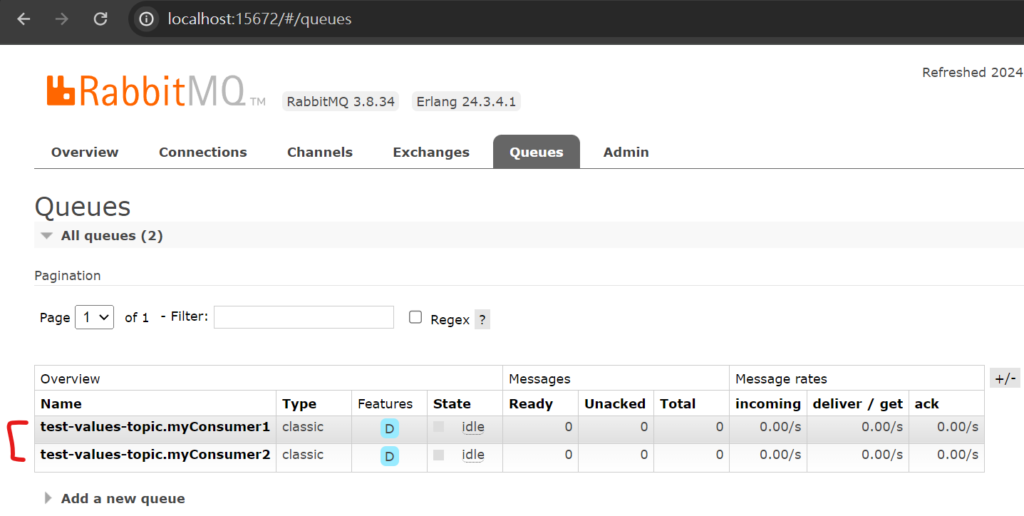
然後使用 postman 或是 API Tester 測試程式,傳送一個 hello 訊息:
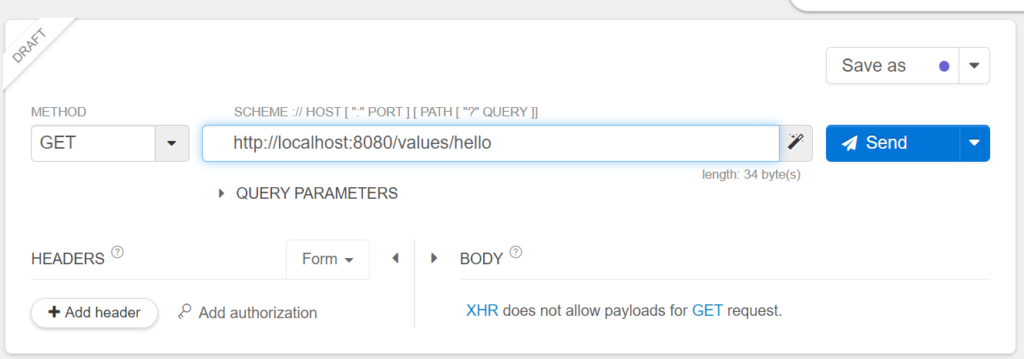
可以看到 consumer1 跟 consumer2 都有接收到 hello 訊息了!
consumer1 的輸出畫面:
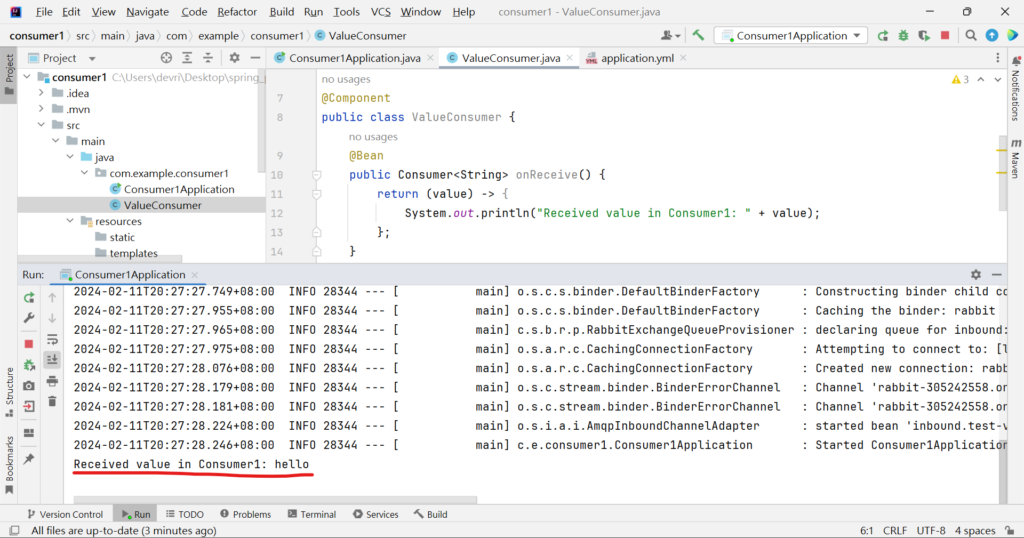
consumer2 的輸出畫面:
